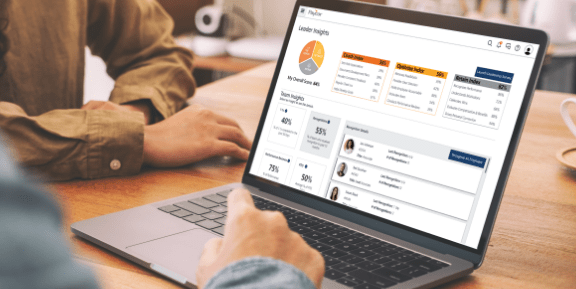HR professionals face mounting pressure to do more with less while delivering exceptional employee experiences. Between managing complex recruitment processes, ensuring seamless onboarding, and maintaining compliance across diverse regulations, HR teams often find themselves overwhelmed by administrative tasks that pull them away from strategic initiatives.
That’s why so many HR leaders are embracing artificial intelligence (AI) solutions to help them keep up. A Gartner survey shows that in 2024, 11% of HR leaders had already implemented AI, while an additional 75% were exploring use cases, planning implementation, and evaluating providers.
Whether you’re in the majority who is using or planning to use AI or you haven’t dabbled into it yet, there’s much to learn about the different types of AI technology, AI benefits, AI challenges, and more. This comprehensive guide covers everything you need to know about AI in HR.
What is Artificial Intelligence (AI) in HR?
Artificial intelligence refers to computer systems that can perform tasks typically requiring human intelligence, such as learning, reasoning, problem-solving, and decision-making. In the context of human resources, AI encompasses technologies that can analyze data, recognize patterns, automate processes, and make intelligent recommendations to support HR functions.
AI use cases (more on that below!) include everything from screening resumes and scheduling interviews to predicting employee turnover and personalizing learning experiences. AI serves as a powerful tool that enhances human capabilities and enables HR teams to make more informed, data-driven decisions while focusing on strategic initiatives that require human insight and empathy.
Types of AI Technology in HR
Different types of AI technologies serve various purposes within HR departments. They include:
- Generative AI: Produces human-like text, images, and other media by understanding and replicating patterns it learns from existing information. In HR contexts, it excels at creating personalized communications, generating job descriptions, and producing training materials.
- Conversational AI: Enables machines to understand and respond to human language in a natural way. It powers chatbots and virtual assistants that can answer employee questions or guide candidates through application processes.
- Deep Learning: A subset of machine learning that uses artificial neural networks to analyze complex data patterns. Deep learning systems can process vast amounts of unstructured data and identify patterns that traditional analytics might miss, making them powerful for predictive analytics and analyzing sentiment from employee feedback.
- Automation: Performs repetitive tasks and processes without human intervention. HR automation can handle routine administrative work, data entry, onboarding, workflow management, HR predictive analytics, and rule-based decision-making.
The Importance of Using AI in HR
The integration of AI technology into HR practices has become essential for companies seeking to remain competitive and efficient in today’s business landscape. For example, among companies that have adopted AI for HR, 64% say recruitment is their top use, according to Society for Human Resources (SHRM) data. In a time when speed to hire makes all the difference in talent acquisition, those companies are at an advantage.
AI eliminates time-consuming manual processes, reduces human error, and provides data-driven insights that lead to better hiring decisions and employee retention strategies. Additionally, AI enables organizations to scale their HR operations without proportionally increasing headcount, making it particularly valuable for growing companies.
Use Cases of AI in Human Resources
AI enhances numerous HR functions, including the following:
Talent Acquisition
AI-powered recruitment technology can process thousands of resumes in minutes, using natural language processing to match candidates with job requirements beyond simple keyword searches. These systems analyze education, experience, and skills to create comprehensive candidate rankings, while predictive analytics forecast candidate success based on patterns from high-performing employees in similar roles.
The technology also enhances candidate sourcing by identifying passive candidates across social media and professional networks. Conversational AI can handle real-time candidate inquiries, provide application updates, and conduct initial screening interviews. This automation reduces time to hire significantly, while improving candidate engagement and helping organizations stand out in competitive talent markets.
Onboarding
With automated workflows and intelligent virtual assistants, AI tools can guide new hires through required documentation, deliver tailored training content based on their role, and track progress in real time. By automatically scheduling orientation sessions and notifying relevant departments of IT and equipment needs, AI ensures a seamless, coordinated onboarding experience.
Conversational AI enhances engagement by answering new hire questions 24/7, from benefits eligibility to company policies, reducing the need for HR staff to handle repetitive inquiries. This not only boosts efficiency but helps new employees feel supported and confident as they integrate into the organization.
Talent Development
AI transforms talent development by identifying skill gaps and creating personalized learning pathways for employees at all levels. Machine learning algorithms analyze performance data, career trajectories, and industry trends to recommend specific training programs, certifications, and development opportunities that align with both individual career goals and organizational needs. AI can also predict which employees are ready for promotion or lateral moves based on their skill development progress and performance patterns.
The technology enables intelligent succession planning by analyzing employee capabilities, performance metrics, and potential indicators to identify high-potential candidates for leadership roles. AI systems can model various succession scenarios and recommend development plans to prepare employees for future positions, while also identifying potential gaps in the leadership pipeline that require immediate attention through targeted recruitment or accelerated development programs.
Professional Development
AI analyzes individual learning preferences, career aspirations, and skill assessments to create customized professional development. The technology tracks learning engagement, completion rates, and knowledge retention to continuously optimize professional development, ensuring employees receive the most effective training formats and content. AI can also connect employees with mentors, internal experts, and peer learning groups based on shared interests, complementary skills, and career objectives.
Intelligent systems provide real-time feedback and coaching recommendations by examining work patterns, communication styles, and project outcomes. AI-powered platforms can suggest specific skills to identify networking opportunities and recommend stretch assignments that align with career goals, creating a continuous development experience that adapts to changing individual needs and market demands.
Workforce Management
Real-time machine analysis of employee data helps HR forecast staffing needs and optimize scheduling and workforce management. It evaluates factors like productivity patterns, project timelines, and absenteeism trends to guide resource allocation and workforce planning.
In addition, AI can detect anomalies — such as spikes in overtime or sudden dips in output — that may indicate burnout, disengagement, or operational inefficiencies. By identifying these trends early, HR teams can intervene and adjust strategies to maintain balance and performance across departments.
Benefits Administration
AI streamlines benefits administration by automating enrollment processes, providing personalized benefits recommendations, and handling routine inquiries through intelligent chatbots. By mining employee demographics, family situations, and historical usage patterns, the system can suggest optimal benefits packages that maximize value for individual employees while managing costs for the organization. AI can also predict benefits utilization trends and help HR teams negotiate better rates with providers.
Intelligent systems simplify benefits communication by creating personalized explanations of complex benefits information, calculating potential savings scenarios, and sending targeted reminders about enrollment deadlines or unused benefits. AI-powered platforms can also detect potential fraud in benefits claims, ensure compliance with regulations, and automate the complex calculations required for benefits administration across different employee categories and locations.
Productivity
Ultimately, AI boosts productivity across HR and the broader workforce by automating routine tasks, such as payroll processing, report generation, and policy enforcement. Intelligent systems ensure consistent application of company rules, freeing up time for HR professionals to focus on strategy and employee engagement.
At the employee level, AI tools provide performance analytics and goal tracking, helping individuals stay aligned with team and company objectives. Real-time insights into progress and workload help both employees and managers make informed decisions, prioritize tasks, and eliminate inefficiencies.
Benefits of Artificial Intelligence in HR
Deloitte data shows HR staff spend up to 57% of their time on administrative tasks. Integrating AI tools across various functions empowers HR teams to focus more on strategic initiatives. Key benefits of using AI in HR include:
- Improved efficiency: Automates time-consuming tasks such as resume screening, scheduling, and benefits processing.
- Data-driven decisions: Analyzes large volumes of HR data to uncover trends and guide workforce strategies.
- Better talent matches: Uses predictive analytics to align candidate profiles with company needs and future potential.
- Enhanced candidate and employee experience: Provides 24/7 support via chatbots and virtual assistants for fast, consistent answers.
- Reduced bias: Offers a more objective and consistent approach to hiring and performance evaluation.
- Cost savings: Reduces administrative overhead by automating routine HR tasks and minimizing human error.
- Scalability: Supports growing organizations by managing increased HR demands without additional staff.
Common Challenges of AI in HR
Using AI of course comes with its downfalls too. These include:
Adoption
Implementing AI in HR often requires significant cultural and operational shifts. Resistance can stem from uncertainty about how AI will change roles, concerns over privacy, or doubts about the technology’s effectiveness. Additionally, integration with existing HR systems and workflows can be technically complex, requiring investments in infrastructure and change management strategies.
Governance
Strong governance helps ensure AI is used in ways that align with company policies and legal standards. Without clear oversight, organizations risk misuse or inconsistent application of AI tools. Governance frameworks must define who owns AI decision-making, how data is managed, and how risks are mitigated across HR functions.
AI Literacy
At the pace new AI tools are being developed, many professionals lack the technical understanding needed to make informed decisions about which ones to use. This knowledge gap can lead to overreliance on vendors, poor implementation, or underutilization of features. Building AI literacy within HR teams is critical to evaluate tools effectively and apply them in a way that adds real value.
Ethical Concerns
AI implementation in HR raises significant ethical questions about privacy, consent, and the appropriate use of employee data for algorithmic decision-making. Organizations must navigate complex issues around monitoring employee behavior, using personal information for predictive analytics, and ensuring AI systems respect individual autonomy and dignity.
Organizations must establish clear ethical guidelines for AI use, implement systems for ethical review of AI applications, and create mechanisms for employees to understand and challenge AI-based decisions that affect them. This requires ongoing dialogue with employees, ethics experts, and legal advisors to maintain ethical standards.
Informational Accuracy
AI systems are only as reliable as the data they’re trained on. Poor data quality, incomplete data sets, or outdated information can lead to flawed AI recommendations that negatively impact employee experiences and business outcomes. Organizations must establish robust data governance practices, implement quality control measures, and regularly audit AI system outputs for accuracy.
Bias
AI systems can perpetuate or amplify existing biases present in historical HR data, leading to discriminatory outcomes in hiring, promotion, and performance evaluation processes. Unconscious biases embedded in past decisions become encoded in AI algorithms, potentially creating systematic disadvantages for certain demographic groups or reinforcing existing inequalities within the organization.
Organizations must implement bias detection tools, establish diverse review teams for AI system development, and create corrective mechanisms when biased outcomes are identified.
Job Security
AI automation often raises fears about job displacement among HR staff and employees. While AI can reduce the need for manual tasks, it also creates opportunities for new roles focused on strategy, analysis, and employee experience. Addressing job security concerns requires transparent communication about AI’s role as a tool to augment rather than replace human capabilities, along with clear plans for reskilling and career development.
Impacts of Artificial Intelligence on Human Resources
Because the integration of AI into HR is relatively recent, the impacts aren’t yet well documented. A January 2024 SHRM survey revealed only 25% of employers were using AI to support HR-related activities, and the majority had only been doing so for about a year.
The most common use of AI in HR so far is for talent acquisition and recruiting. Recruiters note AI saves time, improves the ability to identify top candidates, and reduces recruitment costs.
Employers have also begun dipping their toes into utilizing AI to identify employer health plan members at risk for certain conditions and tailor communications to promote benefits engagement. In a case study of an Aon employer, 20% of identified high-risk members became actively managed by the employer’s clinical programs, for an anticipated claims savings of $2,000 per managed employee.
As organizations continue experimenting with and expanding the use of AI in HR, the long-term impacts will become clearer. Early results suggest potential in both administrative efficiency and strategic workforce management. However, as adoption scales, businesses will need to balance innovation with oversight, ensuring that AI HR tools enhance the human elements critical to effective HR.
The Future of AI in HR
While AI is used across numerous HR functions, HR leaders surveyed by Aon say the technology will have the largest impact on people analytics, talent development, and learning and development.
Looking ahead, the future of AI in HR points toward deeper integration, personalization, and strategic data-driven decision making. As AI systems become more sophisticated, they’ll move beyond automating routine tasks to delivering real-time insights that shape organizational strategy. People analytics powered by AI will help HR teams forecast workforce trends, identify leadership potential, and proactively address retention risks with greater accuracy.
In addition, AI will increasingly integrate with other technologies to create more connected and intelligent HR ecosystems. Seamless connections between AI and human capital management platforms will streamline workflows and provide a 360-degree view of the employee experience. As these capabilities mature, AI will transition from a supportive tool to a central force driving workforce innovation and agility.
Paycor Examples of Artificial Intelligence In HR
Paycor’s human capital management software includes a robust suite of AI features designed to empower HR leaders with the smart tools needed to optimize their operations. The software’s AI, which is human-centered, ethical, accountable, reliable, and transparent, offers the following:
Chatbots
Chatbots have multiple applications for assisting HR teams and company employees. For example, Ask Emma, part of our Benefits Advisor, gives employees real-time support, AI-powered insights, and personalized recommendations throughout the benefits selection process. This saves valuable HR time by cutting down on questions.
Paycor’s AI Analytics Digital Assistant provides company administrators with immediate answers to workforce management questions, like “Which location has the highest number of employee starts?” or “Which supervisor has the highest volume of employee exits?” to inform decision-making.
Smart Sourcing Software
For talent acquisition, Paycor Smart Sourcing automates sourcing and improves candidate diversity. It taps into job boards and databases to help organizations find and connect with the best candidates for every role, even passive job seekers. With that information, the software can curate a prioritized list of candidates per role. The optional diversity setting identifies diverse candidates to boost their participation in the hiring pipeline.
Workforce Assistant
Paycor’s Workforce Management Assistant connects HR and front-line leaders with the intelligent, data-driven tools they need to optimize their workforce. Scheduling Pro automates scheduling processes, ensures compliance, and optimizes shift assignments with features like shift rules and location-based distance calculations. In addition, it offers interactive dashboards for setting labor budgets and tracking scheduling metrics, enabling managers to balance budgets and make real-time adjustments.
Time Card Approval Automation enables automated approvals based on pre-defined score thresholds. Then with AutoRun, HR teams can automatically process payroll on a designated day and time.
Performance Review Technology
For performance reviews, sentiment analysis evaluates manager feedback to ensure constructive and clear communication that resonates with employees. Then Compensation Management automates merit increases.
Maximize Your AI and Human Resources Potential with Paycor
Paycor’s Intelligent HCM integrates intelligence into each of its core functions, from timesheets and scheduling to payroll and performance. We offer:
- Automation of routine tasks to streamline processes
- Personalized experiences that cater to individual needs
- Actionable insights for data-driven decision-making
- Proactive recommendations to guide strategic actions
Transform your leadership and drive growth with Paycor’s Intelligent HCM. Take a guided software tour to learn more.
Artificial Intelligence and HR FAQS
Still have questions regarding AI and HR? Read on.
What is Responsible AI in HR?
Responsible AI in HR refers to the ethical design, development, and use of AI systems to ensure fairness, transparency, data privacy, and accountability in decision-making processes. Check out Paycor’s guiding principles for AI here.
Why is AI Important to HR functions?
AI helps HR teams automate repetitive tasks, improve hiring accuracy, personalize employee development, and make data-driven decisions more efficiently.
Will Artificial Intelligence Replace Humans in HR?
No. AI is a tool that augments human capabilities, handling administrative tasks so HR professionals can focus on strategic, people-centric responsibilities.
How Will AI Affect Human Resources in the Future?
AI will continue to reshape HR by enhancing people analytics, streamlining talent management, and integrating with other systems to deliver real-time insights and personalized experiences.
How Will AI Impact Jobs?
AI will change job roles by automating routine tasks and creating demand for new skills. It’s more likely to transform jobs than eliminate them, especially in HR.









